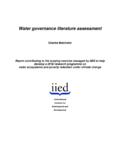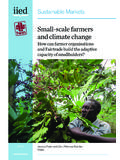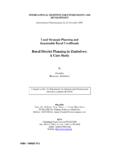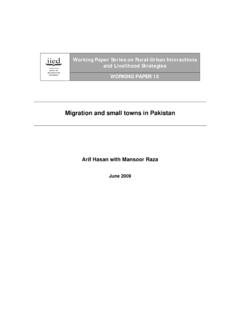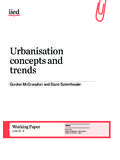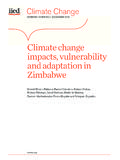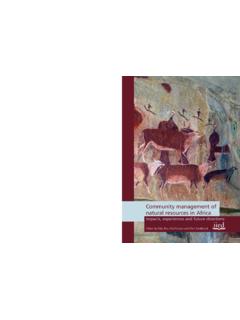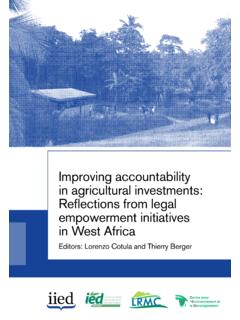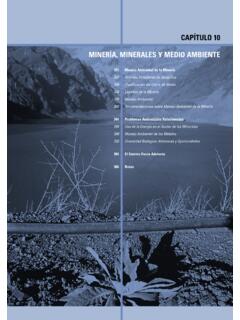Transcription of Mining for the Future. Appendix H: Ok Tedi Riverine ...
1 150 Copyright 2002 IIED and WBCSD. All rights reserved Mining , Minerals and Sustainable Development is a project of the International Institute for Environment and Development (IIED). The project was made possible by the support of the World Business Council for Sustainable Development (WBCSD). IIED is a company limited by guarantee and incorporated in England. Reg. No. 2188452. VAT Reg. No. GB 440 4948 50. Registered Charity No. 800066 Mining , Minerals andSustainable DevelopmentNo. 68a April 2002 Mining for the FutureAppendix H:Ok Tedi RiverineDisposal Case StudyThis report was commissioned by the MMSD project of IIED. It remains the soleresponsibility of the author(s) and does not necessarily reflect the views of theMMSD project, Assurance Group or Sponsors Group, or those of IIED or for the Future H 2 Contents 1 Introduction .. 3 2 Background .. 3 Physical Socio-Economic Setting ..4 Mining Operations at Ok Tedi ..6 Waste Disposal at the Ok Tedi Mine.
2 7 3 Environmental Impacts .. 8 Impact on Vegetation ..9 Toxicity and Water Quality ..11 Decrease in Fish 4 Socio-Economic Impacts .. 12 5 Governance and Drivers Behind Decision Making at Ok Tedi .. 15 6 Conclusions .. 18 References .. 18 Annex H1. Landsat Diagrams of the Ok Tedi Dieback in 1998 and 2000 .. 19 Annex H2. Litigation History of the Ok Tedi 20 Appendix H: Ok Tedi Riverine Disposal Case Study H 3 1 Introduction The Ok Tedi Mine in papua New guinea (PNG) is one of the mines where Riverine disposal is currently being practised. It is one of the world's largest gold-copper mines and was owned by BHP Billiton (52%), the State of papua New guinea (30%) and Inmet Mining Corporation (18%). Of the state s interest, 15% is held on behalf of the nation, on behalf of the people of the Western Province and on behalf of the local BHP Billiton have recently withdrawn from the project and its equity has been transferred to the Sustainable Development Program Ok Tedi Mining Limited (OTML) has attracted a lot of publicity, not only because of the consequences of Riverine disposal, but also the socio-economic impacts to the local community.
3 After having been involved in a number of highly publicised compensation claims and following the most recent round of scientific predictions of environmental impacts from the mine, BHP Billiton proposed to the State that a valid compromise between the economic needs of the State and communities, on the one hand, and environmental values on the other, would be to work towards closure by 2005, five years earlier than otherwise planned. This was not acceptable to the State, which wants to see the mine continue for its maximum economic life. This is attributed to the fact that the mine is the largest industrial and commercial enterprise in the country and constitutes a major source of PNG's foreign exchange earnings. In 2000, export sales from the mine were worth million and represented about 18% of PNG s foreign exchange It has also contributed to social and infrastructure development in one of the remotest region in the country.
4 In these circumstances BHP Billiton decided that continued involved with the mine was inconsistent with its Charter, and negotiated with the State and Inmet to withdraw from OTML. This paper discusses the sustainable development issues of Riverine disposal on the Ok Tedi region and the PNG as a whole. 2 Background Physical Setting The Ok Tedi mine is found in the Star Mountains region in the interior of the Western Province of PNG, adjacent to the border with Irian Jaya, Indonesia (Figure H1). The Ok Tedi open pit operations are located on Mount Fubilan, about 1,800 m above sea level. The mine is situated in the Fly River catchment, in the headwaters of the Ok Tedi River in the Star Mountains. The Fly River System which drains southwards has three primary branches, the Ok Tedi, the Fly and the Strickland (Figure H2). The Ok Tedi joins the Fly at the 1 BHP (1999) BHP and Ok Tedi, Discussion.
5 Website 2 Ok Tedi Mining Limited Ok Tedi Ready to Continue Without BHP Billiton. Media Statement, February 2002. 3 See Ok Tedi Mining Limited, website at (Accessed April 2002.) Mining for the Future H 4 Figure H1. Location of the Ok Tedi Mine within papua New guinea D Albertis Junction, about 846 river km from the delta at the coast. The confluence of the Strickland and Fly Rivers is about 6 m above sea level. Below this junction, the Fly River flows another 432 km to the delta mouth (Dietrich et al., 1999). In this region, landslides occur on almost a daily basis. This is attributed to two forces, besides gravity, that generate the high energy, erosional landscape; the high torrential rainfall and the high frequency of earth tremors and earthquakes. The earthquakes often measure more than 7 on the Richter scale and they regularly trigger massive rock falls and landslides (Minerals Council of Australia, 2000).
6 papua New guinea has an equatorial climate with nearly uniform temperatures throughout the year, averaging 260C (Clarke, 1996). The region where the mine is located is one of the wettest areas in the world. It experiences extremely high rainfall of over 10,000 mm per year (Murray et al., 2000). This is evenly distributed throughout the year. Socio-Economic Setting The Star Mountains region of PNG was one of the last regions in the country to develop. At the time the ore body was discovered, local villagers lived a subsistence life style based on traditional gardening and hunting. There was little assistance in terms of infrastructure, health care or education, though the church missions played and continue to play a pivotal role in the provision of health and educational services. Appendix H: Ok Tedi Riverine Disposal Case Study H 5 Figure H2. Location of the Ok Tedi Mine in relation to the Fly River Catchment In 1980 it was estimated that 73,500 people lived in the Ok Tedi/Fly River drainage area.
7 Of these, OTML's compensation and community improvement programmes include around 50,000 people (Buhupe, 1998). Approximately 10,000 people live in the company township of Tabubil and about 5,000 additional people have created settlements on the eastern edge of the town, outside the boundary of the OTML 4 BHP (1999) BHP and Ok Tedi, Discussion. Website Mining for the Future H Mining Operations at Ok Tedi The mountains of the Western Province consist of Mesozoic and Cainozoic marine sediments. The older sediments at the base of the mountains are mudstones and sandstones, strongly bedded, structurally weak and easily erodable. Overlying these strata are various limestones and other calcareous rocks (Minerals Council of Australia, 2000). These limestones were injected with volcanic intrusions that make up the orebody (Box H1).
8 The intrusion that forms the Mt Fubilan ore body consisted of a gold gossan cap which had been leached of copper, underlain by a porphyry copper and skarn ore. On average, the orebody is less than 1 km2 in area and about 800 m deep. Box H1. Geologic formation of the Ok Tedi ore body During Miocene, the geological era that lasted from the 23 to the 3 million years age, volcanic intrusions injected a variety of molten igneous and other materials into the limestone. Mt Fubilan contains two intrusions that occurred about million years ago. The larger intrusion is the ore deposit being mined by OTML. This is known as the Fubilan Monzonite Porphyry. Subsequent intrusions injected further materials and enriched the mineral forming processes that formed chalcopyrite, bornite and gold. As the mountain weathered, chemical leaching in the surface layers caused a separation of the copper and gold.
9 The upper layer of the intrusion was leached of copper leaving a gold gossan (Minerals Council of Australia, 2000). This limonite material of 50 million tonnes with grams of gold per tonne was mined out during the first few years of mine life (Hettler et al., 1997). Beneath the concentrated gold cap, rich ores of copper (now being mined) are contained in the form of chalcopyrite and digenite minerals. The Mt Fubilan orebody was discovered in 1963 by a government patrol leader who noticed signs of copper mineralisation. In 1976 the Mining (Ok Tedi Agreement) Act was passed by parliament which outlined all the obligations and rights pertaining to the development of the Mt Fubilan deposit. The PNG Government granted permission for a consortium of Mining companies, that later became the Ok Tedi Mining Limited (OTML), to develop the Ok Tedi mine in 1980, with an understanding that conventional environmental controls such as stable dumps, to contain most (80%) of the waste rock, and a tailings storage facility would be included.
10 Conventional open pit Mining techniques are used to extract about 30 million tonnes of ore and 55 million tonnes of waste rock annually (BHP, 1999). On average, the mine produces ore at a rate of 80,000 tonnes per day and waste rock at a rate of 152,000 tonnes per day. During the first four years of production, the Ok Tedi mine consisted of a closed circuit cyanide leach and carbon-in-pulp recovery system to extract the gold from the leached cap. The tailings were treated with hydrogen peroxide to destroy the residual cyanide. In 1997, copper processing began with the commissioning of a sulphide flotation and concentrator plant. Gold production ceased in 1988 and the gold now reports to the copper Appendix H: Ok Tedi Riverine Disposal Case Study H 7concentrate. The concentrator plant has a gold recovery of 70% and copper 80% (Hettler et al.)
